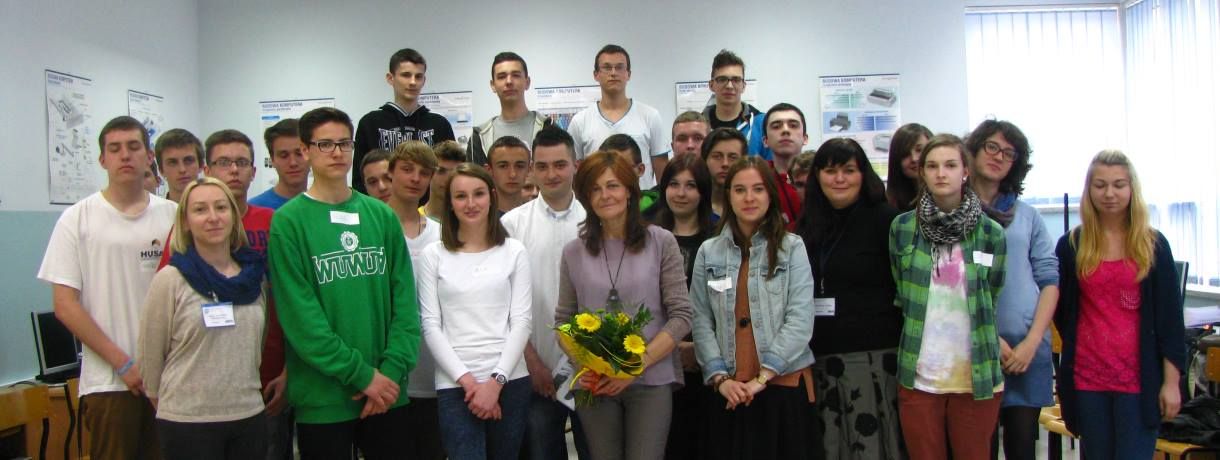| 2014 |
Włocławek
Automotive Vocational School


| 2014 |
2nd Award at 2014 School of Dialogue Gala
Continuing School of Dialogue in 2015, 2016, 2017, 2018, 2019
“After four meetings my perception of the Jewish people has changed completely: intolerance has been replaced by understanding, antipathy turned into sympathy.” The above words were written by one of the participants of the spring School of Dialogue workshops organized in Włocławek, a town in which the Jewish community was very active before the war. It grew and developed. A hotchpotch of assimilated, Chassidic and Lithuanian families. There was a Jewish library with a reading room, Bund, Mizrachi, and Agudat Israel had their offices here, and there was also a Jewish Community School. There was a junior high school for boys and a kindergarten ran in accordance with Fröbl’s methodology. An orphanage, the Jewish Gymnastics Association, and 40 different Jewish papers and magazines. There were active organisations and associations. Free and paid Jewish schools. And a Theatrical Association, of course.
They were physicians and teachers, industrialists, traders. They lived primarily in the Jewish district, established back in 1823. By now it has fallen into decay and ruin, sad and gloomy. People do not go there, they say it’s dangerous and they are afraid. Of ghosts, probably.
8 Zduńska Street where the Jewish Artistic Scene used to be. 35 Królewiecka Street with the Makabi Gymnastics and Sports Association, and 17 Królewiecka Street with the new synagogue that was demolished ten-odd years after it had been erected. It has been replaced by a block of flats. Piekarska Street numbers 2, 3 and 4 where Mogenstaler and Reich-Ranicki lived, and where the Jewish Craft Guild was located. And then Królewiecka Street again with its Talmud-Torah at number 5, the school for the poorest of children, and below it, at number 4, the mikveh – a ritual bath. At 70 Stodólna Street there was a Jewish hospital; now it’s simply a hospital. Mizrachi was located at 54 Łęgska Street, and 3 Maja used to be called Szeroka. At 8 and 16 Cyganka Street were two paid Jewish schools, and at 14 Żabia Street was the old Great Synagogue with turrets and wall paintings, built in Mauritanian style, supposedly to copy the one in Dresden. 16 Żabia Street is where the Hashomer Hatzair Jewish Youth Organisation used to be. And at 9 Kościuszki Street used to be the Jewish coeducational junior high school.
This was the rough itinerary of the walking tour during which 30 people were guided around Włocławek by a group of students from several local schools. But they didn’t go to 25 Nowowiejska Street where the cemetery is. They didn’t, because it’s too far, too late, and actually there’s nothing to see there anymore. Just the vocational school and the commemorative monument. They walked with their younger colleagues, elderly ladies and guests from Israel. They also invited Mr. Tomasz Dziki, manager of the Włocławek branch of the National Archives in Toruń, who told the participants about the influence of minorities on the development of Włocławek’s industry before the war. They invited Mr. Tomasz Wąsik from the City’s History Museum who talked about the minorities that lived in Włocławek before the war. There was also Ms Mirosława Stojak, a local activist and archive worker of the Town Hall, guest of the 4th workshop who provided great support for the students. And there was also Ms Anna Żeglicz, headmaster of the University of the Third Age in Włocławek.
The School of Dialogue participants meticulously prepared for the walking tour. Somebody recorded the reminiscences of his grandmother, someone else went to the Museum to pick up some photographs and gather information.
Some parents provided baked goods, and others found pre-war maps of the city. The deputy director tried to get media coverage in order to inform people that something is going on. In the school’s reading room the students prepared an exhibition. “They survive in our memory. Retracing the footsteps of Włocławek Jews”. They also printed short guides to the Jewish town under the same title. They handed them out to the walking tour’s participants, and carried the rest to Włocławek’s tourist information centre. During the meeting that took place several days after the walking tour they presented the Jewish cut-outs of Ms Ćwiklińska’s, and Judaica from father Raszewski. There were 60 people in attendance, including members of Włocławek Landsmanshaft from Israel. The students served hamantaschen, almond bread and apple pie. They also presented a video clip with boys rapping song they wrote as a part of the project. There was a small orchestra and a film covering the walking tour. The meeting was very moving, and the event got a lot of interest. The guests provided support, and the students felt pride. They also took the second place in the contest. Something good will happen in Włocławek again.

School:
Automotive Vocational School
Honorable Mention:
2nd Award at 2014 School of Dialogue Gala
Continuing School of Dialogue in 2015, 2016
Students:
students from different grades
Teacher:
Anita Kwiatkowska
Expert:
Mirosława Stojak
Educators:
Katarzyna Czajkowska-Łukasiewicz, Maria Pawlak
In appreciation to the Conference on Jewish Material Claims Against Germany (Claims Conference) for supporting this educational program. Through recovering the assets of the victims of the Holocaust, the Claims Conference enables organizations around the world to provide education about the Shoah and to preserve the memory of those who perished.

In appreciation to Friends of the Forum for supporting the School of Dialogue educational program.
